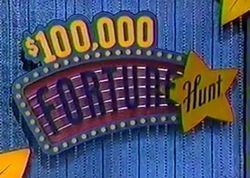Narrated by Bill Barber No. of seasons 5 Original release 1989 – 1994 Final episode date 1994 Genre Game show | Country of origin United States First episode date 1989 Number of seasons 5 | |
 | ||
Similar Illinois Instant Riches, Animal Rescue, On the Spot, Missing, Independent Network News | ||
100 000 fortune hunt illinois lottery game show premiere
The $100,000 Fortune Hunt is an Illinois Lottery game show which debuted on September 16, 1989, and aired on Saturday evenings from 1989-1994 on WGN-TV in Chicago (except for 1 year in 1993 when it aired on WBBM-TV); it was also broadcast on WGN's national satellite feed. Jeff Coopwood hosted the first season, with the rest of the run being hosted by Mike Jackson. Linda Kollmeyer served as the hostess during the entire run with Bill Barber as the announcer.
Contents
- 100 000 fortune hunt illinois lottery game show premiere
- Illinois lottery 100 000 fortune hunt 8 4 90 lisa shanklin winner
- Gameplay
- Bonus play
- References
Illinois lottery 100 000 fortune hunt 8 4 90 lisa shanklin winner
Gameplay
Potential contestants purchased a $100,000 Fortune Hunt scratch-off ticket from an Illinois Lottery retailer. To play the "$100,000 Fortune Hunt" players rub off the play area on the lottery instant ticket. If three matching prize amounts are revealed, the player wins the prize shown-such as a free ticket or up to $100. If three TV symbols appear, players can submit the ticket to the lottery for a preliminary drawing. This drawing will be held every week in Springfield.
At this first stage each week, six on-air contestants and 12 at-home viewers will be selected from the preliminary drawing of entry tickets and asked to participate in the "$100,000 Fortune Hunt". Only the first six contestants will appear on the TV show and have the opportunity to win the grand prize or other prizes. Two of the 12 at-home viewers are assigned to each of the six on-air contestants as partners.
While one of the six who appear on the game show will win the grand prize, his or her two home "partners" will win $500 each. Each of the remaining five on-air contestants will receive at least $1,000, and their partners will receive $100. During the TV show, the six contestants will face a game board with 36 numbered panels. Each panel will reveal a plus or minus dollar amount (scores can never go below zero); players will try to accumulate the most money by randomly selecting panels. There will be special panels such as bankrupt, lose a turn, wipeout, and double. The player who collects the highest prize amount after five rounds is declared the winner and receives the $100,000 grand prize. The other contestants, one at a time, would then given a choice to keep their total winnings or trade them for a choice of prizes (hidden behind 12 numbered panels). These range from cash amounts totaling between $1,000 and $10,000 to merchandise such as rooms of furniture, trips, a big screen television, a camcorder combo, and many others. These rules only lasted the first seven months the show was on the air.
At the end of each show, hostess Kollmeyer drew six tickets at random from a revolving drum. The players who purchased those tickets were selected as the contestants for the next show.
Other spaces included:
At the end of the game, the player in the lead won $100,000. During the final season, the winner returned the following Saturday, up to five weeks. If the game ends in a tie, another round is played against the tied players.
Bonus play
On April 14, 1990, a new scratch-ticket was introduced with a new home-player rule. Each contestant would be designated with a letter from A-F from left to right. Later on, the contestants were also given letters from G-L, again from left to right. At the end of the show, home viewers would be given a chance to win $100 playing the at-home Bonus Play game. The winning contestant spun a wheel with 10 spaces numbered 0-9.
The winning number would consist of the $100,000 winner's letter(s) followed by a 4-digit number which the studio contestant created with four spins of the Bonus Play wheel.
Any home viewer whose Bonus Play ticket number matched the contestant's letter and the 4 digits in the order they were spun would win $100.
All Bonus Play tickets were good to last forever. So home viewers could keep them for the next drawing whether they were winners or not.
Sometime in the show's second season, the home player element was dropped from the show altogether.
